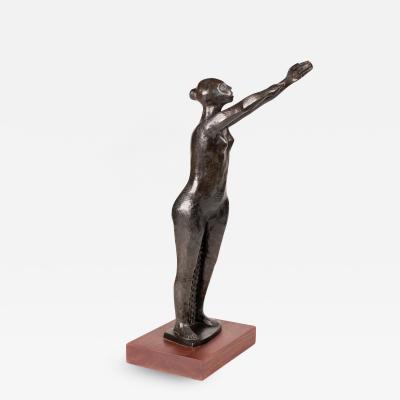Elizabeth Catlett
American, 1915 - 2012
Delve into the captivating works of Elizabeth Catlett, an artist renowned for her abstracted sculptures depicting the human form. Catlett's artistic journey, shaped by studying under Grant Wood and Ossip Zadkine in the 1940s, transformed her naturalistic figurative sculpture and painting into a modern style. Her oeuvre and legacy are a potent synthesis of modernist influence, historical African American and Mexican artwork, and personal experiences.
Using simple, clear shapes, Catlett masterfully captures both the physical and spiritual essence of her subjects. Whether crafting hardy laborers or nurturing mothers from wood, stone, bronze, or clay, she demonstrates extraordinary technical virtuosity. Catlett seamlessly melds her curving female forms with the grain, color, or luster of her chosen medium, revealing the inherent beauty in both her subjects and materials.
After graduating cum laude from Howard University in 1935, Catlett faced racial biases and prejudices firsthand, notably when a scholarship to the Carnegie Institute of Technology was revoked due to her race. Her work resonates with these experiences, addressing the societal challenges she encountered throughout her lifetime. Catlett's commitment to social justice is evident in her roles as a studio teacher and her active participation in protests and picketing.
A pivotal moment occurred in 1946 when Catlett accepted a grant from the Rosenwald Foundation, moving to Mexico City to study printmaking. Joining the Taller de Gráfica Popular, a politically influential group of printmakers, she embraced using art in the service of struggling people. Her art became a powerful tool for realism meaningful to those she aimed to represent.
Relocating from the United States to Mexico in 1946, Catlett faced repercussions for her political actions, eventually becoming a Mexican citizen after being labeled an "undesirable alien" by the U.S. State Department. From 1958 to 1976, she taught at the National School of Fine Arts in Mexico City, leaving an indelible mark on realistic and highly stylized two- and three-dimensional figures.
Catlett's extensive body of work includes lithographs, linoleum cuts, and sculptures that draw inspiration from African American and Mexican life. Her art captures the unique strength and endurance of women while shedding light on issues of social, cultural, and political oppression, employing simple, clear lines to convey her powerful narratives. Charlotte Streifer Rubenstein, author of "American Women Artists," hails Alice Elizabeth Catlett as "considered by many to be the greatest American black sculptor."
Using simple, clear shapes, Catlett masterfully captures both the physical and spiritual essence of her subjects. Whether crafting hardy laborers or nurturing mothers from wood, stone, bronze, or clay, she demonstrates extraordinary technical virtuosity. Catlett seamlessly melds her curving female forms with the grain, color, or luster of her chosen medium, revealing the inherent beauty in both her subjects and materials.
After graduating cum laude from Howard University in 1935, Catlett faced racial biases and prejudices firsthand, notably when a scholarship to the Carnegie Institute of Technology was revoked due to her race. Her work resonates with these experiences, addressing the societal challenges she encountered throughout her lifetime. Catlett's commitment to social justice is evident in her roles as a studio teacher and her active participation in protests and picketing.
A pivotal moment occurred in 1946 when Catlett accepted a grant from the Rosenwald Foundation, moving to Mexico City to study printmaking. Joining the Taller de Gráfica Popular, a politically influential group of printmakers, she embraced using art in the service of struggling people. Her art became a powerful tool for realism meaningful to those she aimed to represent.
Relocating from the United States to Mexico in 1946, Catlett faced repercussions for her political actions, eventually becoming a Mexican citizen after being labeled an "undesirable alien" by the U.S. State Department. From 1958 to 1976, she taught at the National School of Fine Arts in Mexico City, leaving an indelible mark on realistic and highly stylized two- and three-dimensional figures.
Catlett's extensive body of work includes lithographs, linoleum cuts, and sculptures that draw inspiration from African American and Mexican life. Her art captures the unique strength and endurance of women while shedding light on issues of social, cultural, and political oppression, employing simple, clear lines to convey her powerful narratives. Charlotte Streifer Rubenstein, author of "American Women Artists," hails Alice Elizabeth Catlett as "considered by many to be the greatest American black sculptor."
